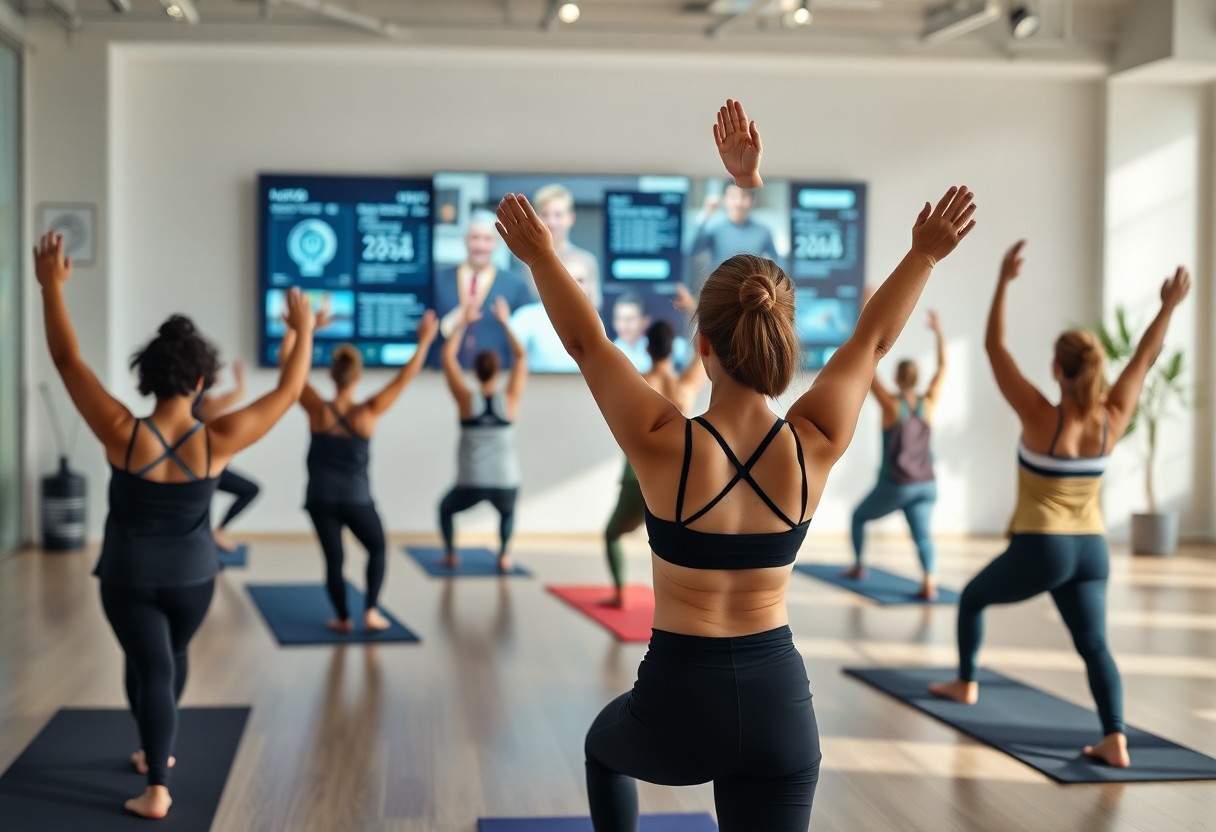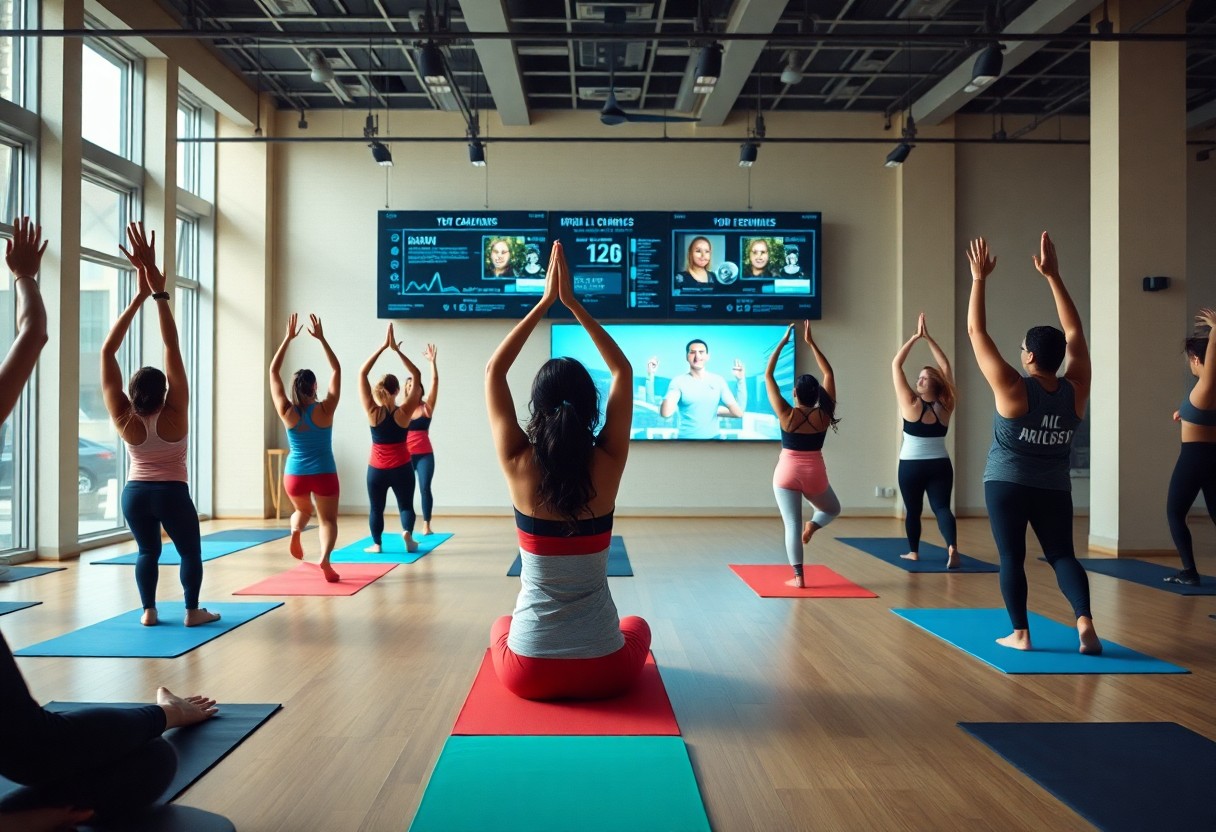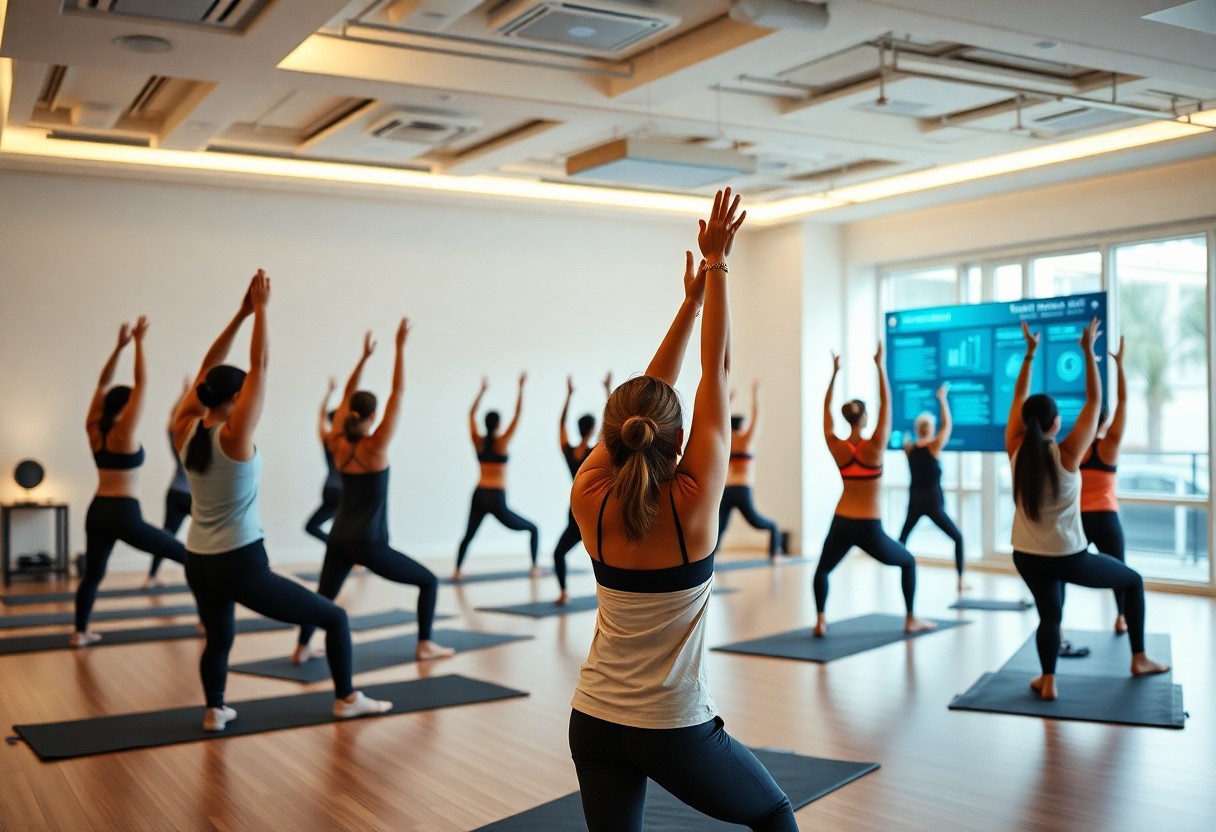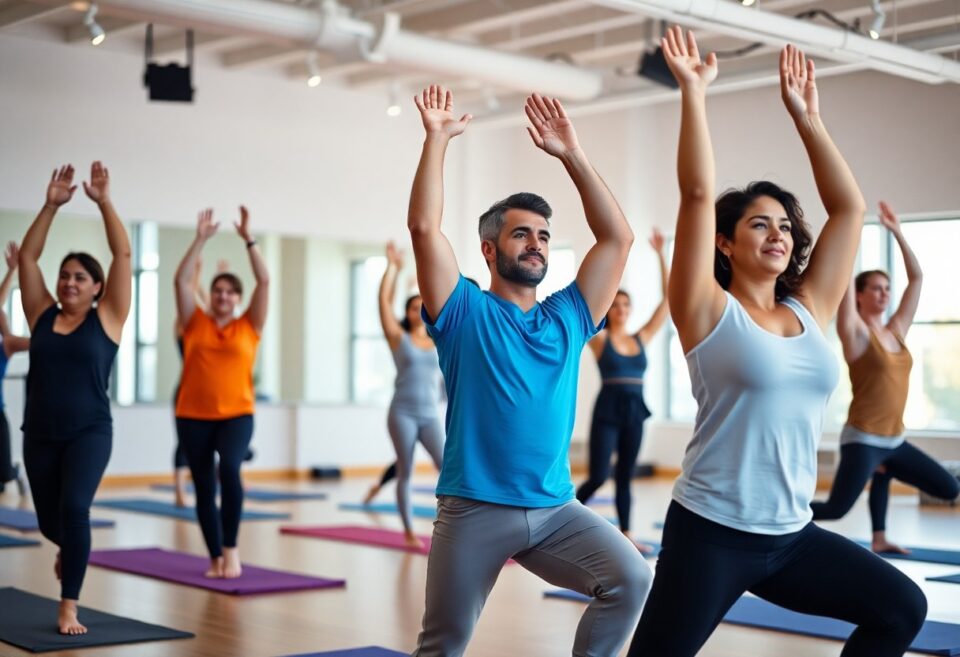Esoteric technologies like AI are revolutionizing how you approach yoga, tailoring every pose and session to your unique needs. By integrating AI, your workout becomes smarter, safer, and more effective, adapting in real-time to your progress and physical limits. This personalized approach helps avoid injury and enhances flexibility, making each session deeply engaging. With AI guiding you, your yoga practice is no longer generic; it’s a customized journey that evolves with your body and mind. Embracing this fusion of tradition and technology, you unlock a powerful way to elevate your wellness routine.
The Evolution of Yoga in the Digital Age
As you explore the intersection of yoga and technology, it’s fascinating to observe how yoga has evolved over the years, particularly with the advent of digital platforms. What was once a practice passed down through in-person instruction and community-based classes has expanded into an accessible, globally connected experience. The rise of online yoga classes, instructional apps, and video platforms means you can now engage in personalized sessions from the comfort of your home or while traveling. This digital shift not only breaks down geographical barriers but also caters to diverse schedules, allowing you to practice whenever it suits your lifestyle best.
The integration of technology into yoga has also brought about the emergence of advanced tools, such as wearable devices and AI-powered apps, that monitor your form, track your progress, and suggest improvements tailored specifically to you. These innovations are revolutionizing the way you approach your practice by offering real-time feedback and adapting sessions based on your individual needs and goals. The continuous data collection and analysis of your performance provide detailed insights that were previously unavailable through conventional instruction, enabling a more focused and effective workout.
However, as you embrace digital enhancements, it’s important to balance technology with the mindful, spiritual elements that make yoga more than just physical exercise. The digital age invites you to harness these modern tools while maintaining the essence of yoga’s holistic benefits. This evolution is not just about convenience, but also about how technology can deepen your connection to the practice, your body, and your mind, creating a more immersive and enriching experience that blends tradition with innovation.
Analyzing AI’s Role in Enhancing Mindfulness
AI’s capabilities extend far beyond simple workout customization; they have a significant impact on enhancing mindfulness within your yoga practice. Through sophisticated algorithms and sensor integrations, AI can help you track physiological markers such as heart rate variability, respiration patterns, and even stress levels during your sessions. This data allows AI systems to provide personalized meditation guidance and breathing exercises that respond dynamically to your current state, helping you deepen your mindfulness and achieve better mental clarity. As you interact with AI tools, you gain a clearer awareness of your body-mind connection, cultivating a more intentional and focused practice.
Moreover, AI-powered virtual assistants and apps are designed to recognize signs of distraction, fatigue, or emotional fluctuation during sessions, offering gentle prompts to guide you back to your breath and posture. These features minimize the risk of your sessions becoming mechanical or rushed, fostering a meditative atmosphere that supports sustained attention. You might even find that the analytic feedback helps you uncover patterns in your emotional and physical states, encouraging a more compassionate and patient approach to your growth and progress.
Importantly, AI’s contribution to mindfulness is not without potential pitfalls. The reliance on technology could sometimes detract from your intrinsic sense of awareness if you become too dependent on external cues or data interpretation. It’s crucial to use AI as a supportive tool rather than a replacement for your inner intuition and self-reflection. The balance between technology-enhanced mindfulness and personal insight forms the foundation for a truly transformative yoga experience in this digital era.
To explore deeper into AI’s role in mindfulness, consider how emerging technologies like emotion-sensing wearables and neurofeedback devices are being integrated into yoga practices. These devices analyze neural activity and emotional responses, offering you personalized prompts that encourage deeper states of relaxation or focus. Such advancements highlight the positive potential of AI to transform mindfulness from an abstract concept into a tangible, measurable experience. Yet, there is also a danger in over-reliance on these technologies if they overshadow your personal awareness, risking a loss of connection with your natural rhythms. By critically engaging with these tools, you maximize the benefits of enhanced mindfulness while safeguarding your autonomy in the practice.

The Mechanics of AI-Powered Personalization
When you engage with an AI-powered yoga application, you’re tapping into a sophisticated system designed to understand and cater to your unique fitness profile. These systems typically start by collecting data directly from you—such as your age, experience level, fitness goals, and any physical limitations. Additionally, sensors or wearable devices can provide real-time feedback on your movements, heart rate, and other biometric indicators, allowing the AI to gain a deeper insight into how your body responds during practice. This combination of self-reported and empirical data forms the foundation of the personalization process, ensuring that your workout is tailored specifically for you.
Next, advanced algorithms analyze the gathered information to develop a nuanced understanding of your strengths and areas for improvement. Machine learning models, in particular, play a pivotal role here, as they learn from ongoing user interactions to optimize recommendations. Through continuous feedback loops, the AI adapts to your changing needs over time, modifying pose sequences, session intensity, and rest periods. This dynamic approach allows your workout experience to evolve in alignment with your progress, rather than relying on a static, one-size-fits-all routine.
It’s important to note that AI personalization does not stop at physical adjustments. The technology also considers psychological factors such as your motivation levels and preferred workout styles. By analyzing your engagement patterns and feedback, the AI can suggest practices that resonate better with your personal preferences, fostering a sense of connection and satisfaction in your yoga journey. However, while this system offers a highly tailored workout, you should always be vigilant in assessing your comfort and safety during sessions, as automated adjustments may not always perfectly align with real-time bodily sensations.
Crafting Customized Yoga Routines for Individual Needs
With AI personalization, your yoga routine transforms from generic instruction to a bespoke experience designed around your individual needs. The AI curates sequences that not only align with your current flexibility and strength but also incorporate specific goals such as stress reduction, improved balance, or injury rehabilitation. This tailored approach ensures that every session targets your unique challenges while maximizing the overall benefits of your practice. As a result, you’re more likely to remain motivated, seeing tangible progress that feels relevant to your lifestyle and aspirations.
The customization process also accommodates your schedule and available time, allowing you to choose workouts that fit seamlessly into your day. Whether you want a quick 10-minute stretch session in the morning or a longer, restorative practice before bed, AI can assemble routines that honor your time constraints without sacrificing quality or effectiveness. This flexible design means that your practice remains sustainable and accessible, lowering barriers to consistent engagement—a key factor in achieving long-term wellness outcomes.
Additionally, the AI’s ability to adjust for any physical limitations or health concerns you report ensures that your routine avoids poses or movements that might exacerbate injuries or discomfort. By integrating medical insights and user feedback, the system promotes safety alongside growth. This attentiveness safeguards your wellbeing, creating a balanced practice that respects your body’s signals and encourages mindful progression.
If you’re seeking even deeper customization beyond basic AI-generated routines, some platforms offer options to input more detailed health metrics and preferences, allowing the system to refine your sessions further. This includes the ability to focus on specific chakras, breathing techniques, or meditation styles, making your yoga practice not only physically tailored but holistically attuned to your mind-body connection.

Beyond Flexibility: Tracking Holistic Growth
When you engage in yoga, flexibility is often the first benefit that comes to mind, but your experience extends far beyond this physical trait. Yoga encourages a holistic growth that includes mental clarity, emotional balance, and enhanced mindfulness. With the integration of AI, you can now track these subtle yet profound changes in your overall well-being. By analyzing your breathing patterns, stress levels, and even your emotional states during practice, AI provides a comprehensive view of how your yoga journey is influencing all aspects of your life. This approach allows you to appreciate progress you might not visually witness, such as calming an anxious mind or deepening your meditative focus.
AI-powered tools help you monitor not just your physical postures but also your mental and emotional states over time. Through sensors and biofeedback mechanisms, your emotional fluctuations and stress responses become quantifiable, offering insights into how yoga is helping you manage stress or improve concentration. This data can unveil patterns and suggest more tailored approaches to sessions that align exactly with your personal growth goals. This kind of feedback nurtures a more empathetic and well-rounded practice that fosters balance in both body and mind, empowering you to fully experience the transformative potential of yoga.
By embracing a holistic view of your yoga practice with AI assistance, you position yourself to witness improvements that include better sleep quality, increased energy, and emotional resilience. Instead of focusing narrowly on physical agility, you cultivate a richer, more nuanced journey of self-care. As you use data to inform your sessions, you become adept at recognizing which techniques uplift your spirit, which postures alleviate discomfort, and when a restorative break is needed. This heightened self-awareness leads to a deeper connection with your practice and enhances your capacity to adapt in ways that support your overall well-being.
Data-Driven Insights to Enhance Your Practice
When you adopt AI tools in your yoga practice, the wealth of data collected can significantly elevate the experience and results you achieve. These insights give you a window into details such as your range of motion, muscle engagement, heart rate variability, and breathing efficiency. With this information at your fingertips, you gain a more precise understanding of your body’s capabilities and limitations. AI algorithms can then tailor sequences that challenge you appropriately, ensuring you progress without pushing beyond your safe limits. This personalized approach enhances the effectiveness of each session, making your efforts more focused and efficient.
Moreover, data-driven feedback offers you a way to detect subtle imbalances or weaknesses before they become problematic. For example, if your AI tool identifies a recurring misalignment or uneven muscle activation during poses, it can recommend targeted exercises or modifications to correct these issues. Such early interventions protect you from injuries that could derail your practice, allowing you to maintain a consistent and sustainable routine. This emphasis on prevention paired with progression makes your practice not only safer but also optimized for long-term benefits.
AI’s ability to analyze trends over time means you, too, can track your evolving capabilities and refine your goals intelligently. Instead of guessing when to increase intensity, try new poses, or slow down recovery, you leverage your own data to make informed decisions. This empowers you to feel confident in your practice adjustments, knowing they are backed by solid evidence tailored precisely to your progress. Ultimately, data-driven insights transform yoga from a routine activity into a dynamic and responsive experience that evolves alongside you.
The integration of AI in yoga offers a revolutionary way to blend ancient wisdom with modern technology, giving you unprecedented control over your practice. By continuously learning from your body’s responses and progress, AI not only adapts your sessions in real-time but also inspires a deeply connected and mindful approach to wellness. The positive impact of this precise personalization ensures you make the most out of every session while minimizing the risk of injury. As a result, you develop a sustainable practice that supports your growth holistically—physically, mentally, and emotionally—making your yoga journey truly unique and transformative.

Balancing Technology with Traditional Practices
When integrating AI into your yoga practice, it’s vital to maintain a harmonious balance between advanced technology and the timeless principles of traditional yoga. While AI can provide tailored workout plans, immediate feedback on form, and data-driven progress tracking, you should not lose sight of the spiritual and mindful aspects that define classical yoga. These elements foster inner peace, self-awareness, and holistic health, which technology alone cannot replicate. By combining the analytical power of AI with the meditative and physical disciplines passed down through generations, you can cultivate a more comprehensive and enriching experience.
You may find that AI-powered fitness apps encourage you to push boundaries through data insights, but this should complement rather than replace your intuition and body awareness. Traditional yoga encourages tuning in to your breath and sensations, promoting a deep connection between mind and body that technology cannot fully emulate. The challenge lies in using AI tools as guides or assistants, enhancing your practice without overwhelming the natural rhythm and pace that yoga emphasizes. Your goal is to use technology as a supportive ally, enabling growth while honoring the essence of the practice.
Ultimately, integrating AI in yoga means crafting a personalized approach that respects both innovation and ethics of the tradition. You should seek out AI platforms that offer customization but also encourage you to slow down and reflect. The balance you strike will influence not only your physical development but also the sustainability and authenticity of your practice. As you navigate this intersection, stay mindful of how blending technology and tradition affects your mental, emotional, and spiritual well-being, ensuring your journey remains true to your holistic health aspirations.
The Future of Privacy in Personal Fitness
The rapid advancement of AI in personal fitness introduces significant considerations regarding your privacy and data security. As you utilize AI-driven apps and devices, your personal health information, biometric data, and workout habits become valuable digital assets that developers collect and analyze. While this data enables remarkable personalization, it also exposes you to potential risks such as unauthorized data sharing, breaches, and misuse by third parties. Understanding how your information is stored, processed, and protected is imperative to maintaining control over your personal fitness journey.
You should be aware that current privacy laws vary widely and do not always safeguard fitness data comprehensively. As AI technology evolves, there is a pressing need for clearer regulations and transparent policies to protect your rights. You have the responsibility to scrutinize app permissions, data use agreements, and company reputations before adopting any AI-powered fitness tool. Choosing platforms that prioritize encryption, offer opt-in consent protocols, and allow you to manage or delete your data empowers you to stay secure while benefiting from personalization.
Looking forward, the future of privacy in personal fitness will likely be shaped by advances in secure data frameworks such as decentralized storage and blockchain technology. These innovations promise to give you more autonomy over your data and reduce reliance on centralized data warehouses vulnerable to hacking. The industry’s challenge is to balance AI’s growing capabilities with robust privacy protections, ensuring that your fitness progress does not come at the expense of your personal information’s safety. Staying informed about these developments allows you to make educated decisions about your digital fitness life.
All things considered, the intersection of AI and personal fitness raises important privacy questions that demand your active engagement. As you embrace personalized workout experiences, protecting your sensitive data from misuse should be a top priority. Vigilance in selecting trustworthy technologies and advocating for stronger privacy standards will be vital as you move forward in this digitally empowered fitness landscape.
Tools for a Personalized Yoga Journey
When you begin on a personalized yoga journey, the integration of AI-powered tools can significantly enhance your practice. These advanced technologies analyze your unique physical abilities, flexibility, and preferences to tailor sessions specifically for you. For example, AI-driven apps utilize motion sensors and computer vision to assess your alignment and provide real-time feedback, ensuring that you perform poses safely and effectively. This personalized guidance minimizes the risk of injury and optimizes your progress, transforming a generic workout into a truly customized experience that evolves with your needs.
Beyond just posture correction, these tools often incorporate machine learning algorithms that adapt your workouts based on your performance and goals. Whether you’re seeking relaxation, strength-building, or enhanced flexibility, AI can curate sequences that align with your objectives, making your yoga sessions more engaging and productive. Moreover, the ability to track your progress over time fosters motivation by showing concrete improvements, helping you stay committed to your practice even when life gets hectic. You gain access to a digital coach that understands your pace and preferences intimately.
These platforms also integrate with wearable devices that monitor your biometrics, such as heart rate and respiratory patterns, to fine-tune your practice further. By taking a holistic approach to your physical and mental state, AI-enhanced tools provide a comprehensive experience that supports your well-being on multiple levels. You can explore meditation, breathwork, and mindfulness exercises within the same ecosystem, allowing you to customize not only your physical movements but also the mental and emotional aspects of yoga. This synthesis of data-driven insights and ancient traditions opens up exciting possibilities for personal transformation.
Community and Connection in the Age of AI
Incorporating AI into your yoga journey doesn’t mean you lose the human connection that makes the practice so enriching. On the contrary, AI can foster stronger communities by connecting you with like-minded practitioners around the world. Virtual classes and workshops powered by AI matchmaking algorithms enable you to find groups that align with your level, style preferences, and even time zone. These connections cultivate a sense of belonging, allowing you to share experiences, offer support, and stay motivated alongside others who are on similar paths.
AI-driven platforms also facilitate personalized social experiences where you receive recommendations for instructors, events, and local meetups tailored to your interests. This creates an ecosystem in which you can continuously deepen your practice not just as an individual, but within a vibrant community. Additionally, AI can moderate forums and discussions to maintain positive and respectful interactions, enhancing your online space as a safe environment for learning and growth. By blending technology with human interaction, these communities amplify the collective wisdom inherent in yoga traditions.
Despite the benefits, it is important to be aware of the potential dangers within AI-enabled social spaces, such as privacy concerns and the risk of echo chambers where diverse perspectives may be overlooked. However, with mindful use and responsible platform design, you can navigate these challenges and harness AI as a powerful tool to enrich your connections and deepen your engagement with yoga. These communities not only offer support but also inspire you to explore new dimensions of your practice through shared experiences.
Delving deeper into the intersection of community and AI, you find that the technology enables personalization that extends beyond the physical practice—facilitating emotional and social support that is often missing in solo workouts. AI’s ability to analyze patterns in your interactions helps tailor social experiences that foster meaningful connections. You may engage in collaborative challenges, receive encouragement based on your progress, and connect with mentors who resonate with your journey. This holistic approach makes your yoga practice more than just physical exercise; it becomes a nurturing space to cultivate resilience, mindfulness, and belonging in a digitally connected world.
Conclusion
Now that you have explored the fusion of yoga and artificial intelligence, you can appreciate how this innovative approach personalizes your workout experience in ways traditional practice alone may not achieve. By incorporating AI, your yoga routine becomes tailored specifically to your body’s needs, progress, and goals, allowing for a more effective and engaging practice. You benefit from real-time feedback, adjustments in posture, and personalized flow sequences that adapt dynamically as you improve, which ultimately enhances your safety and maximizes the results you gain from each session.
Your journey with AI-assisted yoga empowers you to deepen your understanding of your body’s capabilities while cultivating mindfulness and physical well-being. The technology acts as a knowledgeable companion that listens to your feedback, tracks your development, and offers actionable insights to guide you toward your best performance. This creates a highly individualized workout experience that respects your unique strengths and challenges, making your yoga practice not only more accessible but also more motivating and enjoyable.
As you continue integrating AI into your yoga routine, you’re embracing a future where exercise becomes increasingly personalized and intelligent. This transformation invites you to take greater control over your health and fitness journey while enjoying the ancient wisdom of yoga enhanced through modern technology. By doing so, you ensure that your practice evolves with you, supporting your well-being in a holistic, adaptive, and sustainable way that meets your lifestyle and goals.
